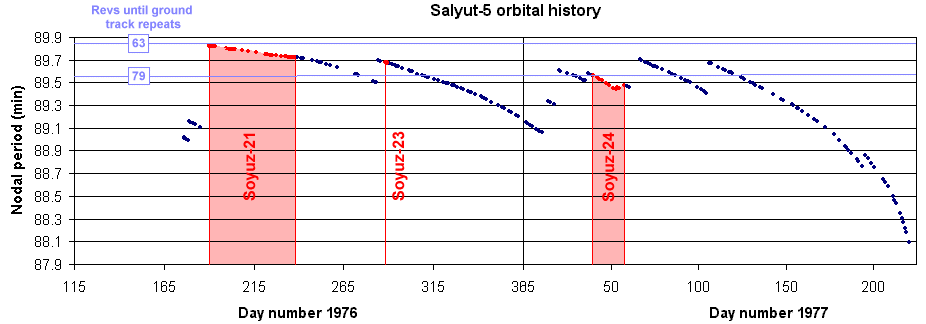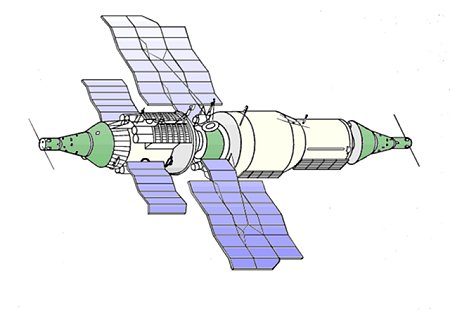 Origins
of the Almaz concept
Origins
of the Almaz concept Origins
of the Almaz concept
Origins
of the Almaz conceptThe plan for launching cosmonauts to the station changed during the conception of Almaz. The original concept indeed included the transport craft (TKS), but for a brief period in 1966-67 a variant of the Soyuz would have been the ferry to bring cosmonauts station (5). Instead Chelomey proposed to let cosmonauts go into space directly with the station by adding a large return capsule to the station. each station would be discarded after the return of the crew. Later, the TKS would be used to resupply the station with crews. As it turned out, delays in developing the TKS, led to the decision in 1970 to use a version of the Soyuz 7K-T ferry to deliver crews to Almaz. This was seen as an interim stage until the TKS would be ready.
(The design of TKS and the history of its flight will be the subject of a separate article under preparation. However, an description of how the Kettering Group tracked the TKS flights can be found in two articles: "Radio Observations of TKS and Related Flights", and "Tracking satellites with a solar radiospectrograph")
The Almaz program was approved in 1967. However, Chelomey regarded the first launch date in 1970 (on Lenin's 100th birthday) given in the approval decree as unrealistic and argued that development would require much longer time. In 1969 the requirement for a prompt "reply" to Apollo prompted the Soviet leadership to give the Korolev Design Bureau (nowadays Energiya NPO [Scientific Production Association]) the task of launching a space station (17K [DOS]) using some elements from the Almaz design. Chelomey was ordered to transfer Almaz drawings to Korolev's Design Bureau. By 1970 eight ground test articles and two flight-rated Almaz (OPS) "spaceframes" were manufactured by Chelomey's Khrunichev Plant. However, by the order of MOM these frameworks were passed to Korolev's Design bureau for implementation of their 17K (DOS) project. In addition, Chelomey was directed to use Korolev's 7K (Soyuz) spaceships instead of TKS during flight testing of OPS. The stations developed by Korolev's bureau based on Almaz used subsystems derived from Korolev's Soyuz spacecraft and flew first in space starting in 1971 under the name Salyut-1.
 The
transfer of know-how to Korolev's bureau delayed the Almaz program for
two years. Howeveer, this was at the height of the arms race and the Salyut
design of Korolev's design bureau did not have the reconnaisance capabilities
of the Almaz concept. Russian journalists have written (1)
that the Central Committe were taken in by Almaz' as a "space fortress"
which was seen as "a response to Chamberlain" (2).
So the Almaz project continued. The amazing situation developed:
Two Soviet manned station programs were running at the same time.
This confounded Western observers - and indeed myself and the members of
the Kettering group of satellite radio trackers (see
separate article)
The
transfer of know-how to Korolev's bureau delayed the Almaz program for
two years. Howeveer, this was at the height of the arms race and the Salyut
design of Korolev's design bureau did not have the reconnaisance capabilities
of the Almaz concept. Russian journalists have written (1)
that the Central Committe were taken in by Almaz' as a "space fortress"
which was seen as "a response to Chamberlain" (2).
So the Almaz project continued. The amazing situation developed:
Two Soviet manned station programs were running at the same time.
This confounded Western observers - and indeed myself and the members of
the Kettering group of satellite radio trackers (see
separate article)
That Almaz was seen indeed a military spacecraft - a "fortress in space" can be inferred from the persistent reports that these stations were equipped with weapons:
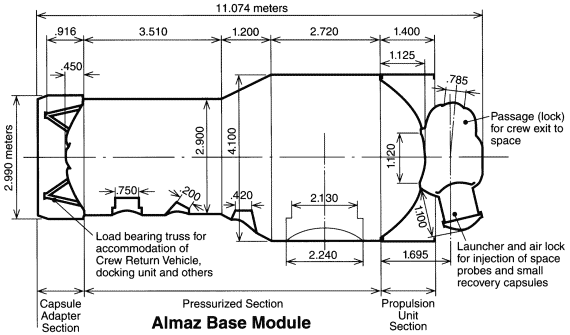
 The
Information return capsule
The
Information return capsuleThe formula below is a very simple relationship between orbital altitude (h), ground resolution (r), focal length (f), and film resolution (p).
p/f=r/h or r= h × p/f
For Almaz h = 270 000 m and f = 6.3 m. So, let us assume that the film used in the Agat-1 camera had the same resolution as the used in early CORONA flights, i.e. 100 line pairs per millimeter. This means that two dark lines 1/100 mm apart with a lighter area in between can be resolved by the film if properly exposed and if proper ground motion compensation was implemented. The film resolution p can the be written: p = (1/1000) × (1/100) and the ground resolution becomes:
r = (270000/(100000 × 6.3)) = 27/63 = 3/7 = 0.43 m
Later CORONA flights had a resolution of 160 line pairs per millimeter, which would have corresponded to a ground resolution of 0.27 m..
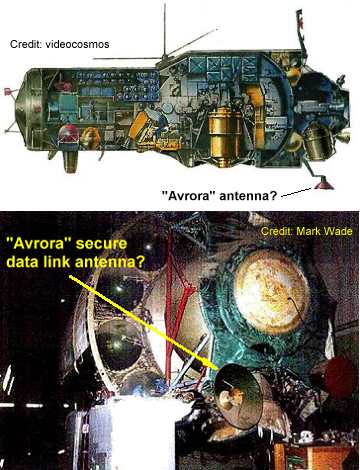 The
minimum aperture diameter (D) required to satisfy the diffraction limit
criterion for the Agat-1 telescope can be estimated by the following formula:
The
minimum aperture diameter (D) required to satisfy the diffraction limit
criterion for the Agat-1 telescope can be estimated by the following formula:
D = 1.22 × L × f/p
where L is the average wavelength of the film sensitivity, here assumed to 0.5 micrometer.
D = 1.22 ×0.5 × 10-6 × 6.3 × 105 = 0.4 m
We know that the aperture diameter was five times large about 2 meters, which was probably dictated by the required signal to noise ratio and the chosen exposure time.
Data from this reconnaissance payload on Almaz could be returned not only via the KSI, but also through a radio link to the ground. It seems that film from the reconnaissance cameras would be developed on board, scanned and transmitted to the ground - all within 30 minutes (5). Considering the secret nature of the Almaz program and the Soviet obsession with secrecy the downlink for the reconnaissance pictures the downlink must have been designed to be secure. In addition to encryption it seems natural that some kind of directional antenna would have been used. When I looked through pictures of Almaz that I had downloaded to my computer I kept an eye out for such an antenna. I think I have been able to identify a good candidate for the antenna system of the secure data link called "Avrora"(5).
The picture on the right
shows two independent views of the Almaz base block and there is a small
dish antenna, with a diameter of about 0.7 meters, near the rear part of
the 4.15 m cylindrical section. If the frequency 10 GHz was used the beamwidth
of this antenna would have been about 3 degrees, which would have resulted
in a coverage are on the ground of about 15 × 30 km at 30 degrees
elevation. Clearly, this was a small enough area to avoid eavesdropping.
However, the dish antenna had to be steered to point at the ground station.
| Function | OPS (Almaz) | DOS | 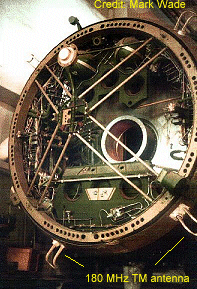 |
| Support telemetry | 19.944 MHz (FSK-PDM)
19.992 MHz (?) |
15.008 MHz (CW-PDM)
(Sal. 1,4,6,7)
20.008 MHz (CW-PDM) (Sal. 1,4,6,7) |
|
| Main telemetry | 181.0/180.0 MHz (PPM-AM) | 192.0 MHz (PPM-AM)
(Sal. 4,6,7)
166.0 MHz (PPM-AM) (Sal. 7) |
|
| Main voice link | 143.625 MHz | 121.75 MHz Salyut 4,6
142.417 MHz Salyut 7 |
|
| Command system | 2365-2375 MHz down?
7190-7210 MHz up? |
922.754 MHz down
768.96 MHz up |
|
| Radar transponder | ? | 2802 - 2860 MHz down
2725 MHz up |
The 180 MHz telemetry antennas
can easily be located on the Almaz base block. Four folded dipoles are
located on the VA capsule adapter section at the front of the station as
shown in the picture on the right side of the table. The shortwave "support"
telemetry antennas can be found on the cone connection the main 4.15 m
diameter cylinder and the smaller diameter section of the station.
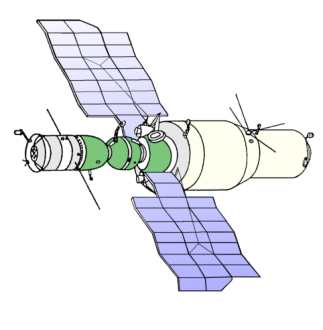 Scaled
back Almaz for flight testing
Scaled
back Almaz for flight testing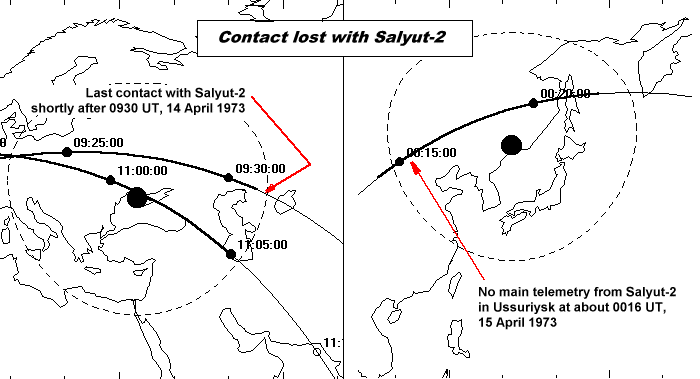
The offcial reason for the failure seems to put the blame on the propulsion system causing the rupture of the hull, even though the explanation provided is somewhat difficult to interpret. It seems to indicate a "stuck thruster" (5): "...led to a continuous working of the low-thrust stabilization engines and significantly increased its temperature, that caused overheating..." This explanation is also cited by a a Western source at the time (6). Another theory advanced by engineers in Chelomey's organisation was that a fragment of the exploded Proton's third stage penetrated the skin of the space station.
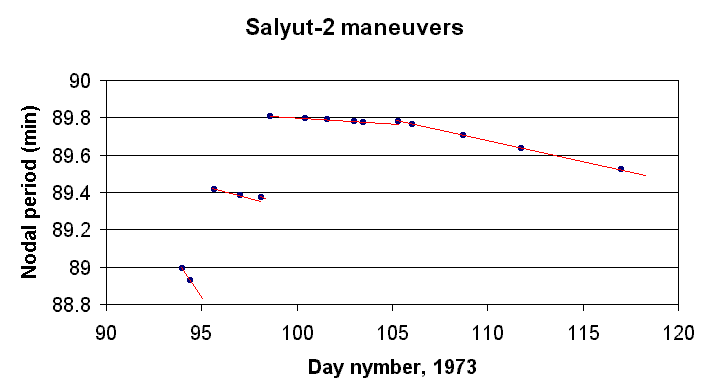

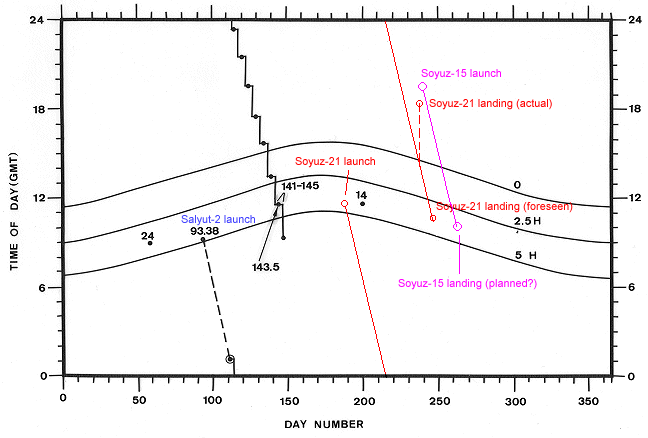
 Salyut-3,
another Almaz (OPS No 0102), was launched into space from launch
site 81L at Baikonur at 2238 UT on 24 June 1974. The picture on the
right shows Salyut-3 in the checkout shop (at Baikonur?) (9).
Interestingly it is labeled "Salyut" at the base. As can be seen in the
graph of nodal period as a function of date for Salyut-3 during 1974 the
Soyuz-14 ferry with cosmonauts Popovich and Artyukhin was launched when
the space station had set up on orbit that almost exactly repeated every
four days. In this way, launch opportunities to rendezvous and dock withn
the station occured every four days. It took the station 9 days to reach
this orbital altitude.
Salyut-3,
another Almaz (OPS No 0102), was launched into space from launch
site 81L at Baikonur at 2238 UT on 24 June 1974. The picture on the
right shows Salyut-3 in the checkout shop (at Baikonur?) (9).
Interestingly it is labeled "Salyut" at the base. As can be seen in the
graph of nodal period as a function of date for Salyut-3 during 1974 the
Soyuz-14 ferry with cosmonauts Popovich and Artyukhin was launched when
the space station had set up on orbit that almost exactly repeated every
four days. In this way, launch opportunities to rendezvous and dock withn
the station occured every four days. It took the station 9 days to reach
this orbital altitude.
An additional factor important for launching a ferry to Almaz was the equator crossing longitude for the space station revolution passing nearest the launch site. If a direct ascent (within a few revolutions) is made to the space station, the longitude of the station equator crossing should be very close to that of a Soyuz launched form Baikonur. Soyuz ferries to early space stations used about one day to reach the station. The altitude of the ferry would be gradually raised to coincide with that of the station. The higher up the station is the larger is the average is the difference in orbital altutde during the rendezvous phase between the ferry and the station. Thus, to reach the station after 24 hours, the initial phase difference along the orbit between the ferry and the station need to be larger the higher up the station is. But to let the orbital planes coincide at launch the equator crossing longitude of the station at the revolution passing closest to the launch site on the day of the launch of the ferry needs to be further east the higher the station is. In that way the proper orbital phasing is achieved when the station's orbital plane drifts westward until the time the ferry is launched. A graph showing this relationship can be seen in a separate article.
Thus, when Soyuz-14 was launched at 1851:08 UT on 3 July 1974 (Day nr: 184), the equator crossing for the Salyut-3 station was 345.15 degrees west. The crew came down on 19 July 1974 (Day nr: 200) which was according to plan if one considers the "landing window" criterion developed by Phillip Clark. Thus, the first visit on board Almaz lasted 14 days. Radio tracking efforts by the Kettering Group during the flight of Soyuz-14 is covered in a special article at this web site.
Soyuz-15 was launched at 1958:08 UT on 26 August 1974 (Day nr: 238). The orbital period of the space station had again been brought up close to the period which yields a ground track that repeats every 63 revolutions, i.e. every four days (see figure showing the "orbital history" below). The Soyuz failed to dock with Salyut-3 and was recovered on 28 August 1974 (Day nr: 240). The IGLA system malfunctioned and the two craft missed each other by a mere 7 meters on the first attempt and 30-50 meters on the second. If one applies the same "landing window" analysis as for Salyut-2 it seems that the flight could have ended around day 261 (18 Sept 1974) which would have meant a 20-21 day stay on Salyut-3. Indeed, in (5) Soviet sources are quoted as indicating that a 25-day flight was planned.
In the figure below the time when the film capsule (KSI) was ejected from Salyut-3 (19 September). It turns out that the recovery of the KSI also satisfies Phillip Clarke's "landing window" criterion. In the diagram below the maneuver to a 63-rev repeating pattern has been indictaed. This could have been in anticipation of another Soyuz launch attempt, but it was probably done to keep the station from decaying and to permit further testst in the unmmaned mode. Salyut-3 was de-orbited intentionally over the Pacific on 24 January 1975. The first Almaz mission was over.
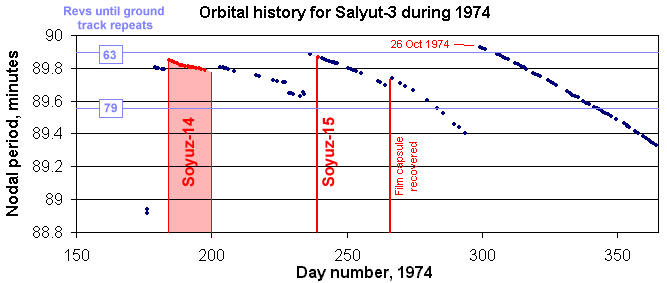
Soyuz-23 launched at 1738:18 UT on 14 October 1976 (Day nr: 288) with V Zudov and V Rozdestvensky was launched. This was at a time when Salyut-5 was in an orbit whose ground track repeated every 9 days (142 revs)! The docking failed and the crew landed at1745:13 UT on 16 October 1976 (Day nr 290). Clark writes (11) that a flight duration of 17-24 days is possible based on "landing window" analysis.
Regular telemetry from the Salyut-5 space station on 180 MHz resumed on 2 February 2, 1977 indicating that a Soyuz launch might be imminent. Soyuz-24 was launched at 1611:50 UT on 7 February 1977 (Day nr: 38). The crew (Viktor Gorbatko and Yuri Glazkov) was supposed to have been wearing breathing masks upon entry into the station (11). This could be an indication that the reports about a foul cabin atmosphere were true. However, the flight proceeded for 18 days and ended at 0936 UT on 25 February 1977(Day nr: 56 ).
The film return capsule (KSI) from Salyut-5 was recovered on 26 February 1977, directly after the return of the Soyuz 24 crew. Salyut-5, the last Almaz space station, burned up in the Earth's atmosphere on August 8, 1977 as can be seen in the graph below where the orbital period plunges towards oblivion requiring only a small rocket nudge to bring it do de-orbit.
